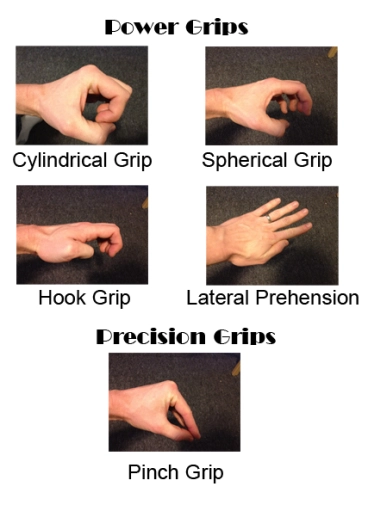Introduction
Power grips are the strongest among all different grips that can be made by humans. Fingers flex to clench an object and forces generated by muscles hold the object firmly and keep it in contact with the palm.
Description of movement
Unlike precision grips, power grips can be distinguished by dynamic and static phases. Dynamic phases involve opening of the hand and thumb while adjusting the fingers to take up a suitable position for grasping an object. Static phases involve fine adjustment of the fingers to assume the shape of the object. Also, muscular antagonism between upper limb digits and middle hand compartments (involving both extrinsic and intrinsic muscles of the hand) is shown in power grip whilst antagonism of interdigital or contradigital antagonism dominates in precision grip, since use of fingertips to hold object is more important (Landsmeer 1962, pp. 164-165)
Execution of power grip can be divided into 4 stages:
- The opening of the hand: involving simultaneous movement of MCP and IP joints;
- The positioning of the fingers: IP joints manipulated to carry out desired curving to hold the object;
- The approach of the fingers to the object: MCP joints adjusts independently from IP joint to approach the object; and
- The transition to the static phase: Objects are drawn into the hand and ‘actual grasp’ occurs. The shape of the object decides the final position of the hand; subclass of power grip used during the static phase (Landsmeer 1962).

Figure A. 5 subclasses of power grip can be performed during transition to the static phase. For instance, spherical grip involves opposition of the thumb and lateral rotation both the little and ring fingers while cylindrical grip involves the ring and little fingers laterally rotated to a maximum (Gelder 2012).
*Did you know?
Hook grip
Hook grip involves flexion digits 2-5 to hold the object in a hook-like manner. Unlike other sub-classes of power grip, the thumb is only involved as a stabilizer and is not involved in weight baring of the object. It also consumes less energy from the long tendons of the fingers (flexor digitorum profundus and superficialis). The thenar muscles are not involved! (Long et al. 1970).

Figure B. A photo representing an example of hook grip. As shown MCP joint is extended (flat middle hand) and both IP joints are flexed to some extent while thumb is not involved in enduring the weight apparently. (Aibolita.com)
Muscles involved
Extension of the MCP joints and flexion of the IP joints are essential in the hook grip. Hence the flexor group of the anterior forearm (flexor digitorum profundus, superficialis and flexor pollicis longus) and extensor digitorum are indespensible for the grip to be executed normally. Also intrinsic muscles (thenar and hypothenar) plus deep muscles (lumbricals and interossei) play important role during the static phase (Long et. al. 1970).
During the power grip, extrinsic muscles are used extensively to provide force for gripping while intrinsic muscles, especially the lumbricals (except 4th) are rarely used. On the other hand, intrinsic muscles (both interossei and lumbricals) are used extensively for abduction, adduction and fine positioning of fingers. Specific extrinsic muscles are recruited for supplying compressive forces and gross motion (Long et al. 1970).
Nerve innervation
The nerves that innervate the hand are median, radial (mainly the superficial branch that supplies the dorsum of the hand) and the ulnar nerve (Pather 2016).
In relation to grip, the median nerve supplies flexor digitorum superficialis, flexor pollicis longus and the lateral half of flexor digitorum profundus. The ulnar nerve supplies the medial half of flexor digitorum profundus, the lumbricals 3 and 4 as well as all interossei muscles. Radial nerve supplies extensor digitorum (Pather 2016).

Figure C. A diagram showing innervation of the palm and dorsum of the hand by three different branches off the brachial plexus. Note the palmar side of the lateral 3.5 digits, finger nails and tips are supplied by the median nerve while both sides of medial 1.5 digits of the hand are supplied by ulnar nerve. Superficial branch of radial hand supplies the rest. (Sanchez 2011)
*Did you know?
Carpal tunnel syndrome, which is signified by compression of the median nerve results in the loss of precision grips due to dysfunction of the thenar muscles (except adductor pollicis). It is also characterized by decreased size in the thenar eminence which leads to loss of opponens action, especially in power grip (Pather 2016).
References
Aibolita.com, Collateral Ligaments of Metacarphophalangeal and Interphalangeal Joints of Third Digit, digital image, accessed 5 May 2016, <http://aibolita.com/sundries/12093-collateral-ligaments-of-metacarpophalangeal-and-interphalangeal-joints-of-third-digit.html>.
Gelder, LV 2012, 5 different types of grip, Grip Strength Tools, digital image, Dynamic Principles, accessed 5 May 2016, <https://dynamicprinciples.wordpress.com/2012/04/05/grip-strength-tools/>.
Landsmeer, JMF 1962, ‘Power grip and precision handling’ Annals of the Rheumatis Diseases, vol. 21, no. 2, pp. 164-170.
Long, C, Conrad, PW, Hall, EA & Furler, SL 1970, ‘Intrinsic-Extrinsic Muscle Control of the Hand in Power Grip and Precision Handling’, The Journal of Bone and Joint Surgery, vol. 52, no. 5, pp. 853-867.
Pather, N 2016, ‘Upper Limb Nerve Lesions’. lecture presented to ANAT2451-ANAT3141, University of New South Wales, NSW, 4 April 2016.
Sanchez, M 2011, Sensory supply of the hand, digital image, accessed 5 May 2016, <https://quizlet.com/6103165/anatomy-hand-flash-cards/>.